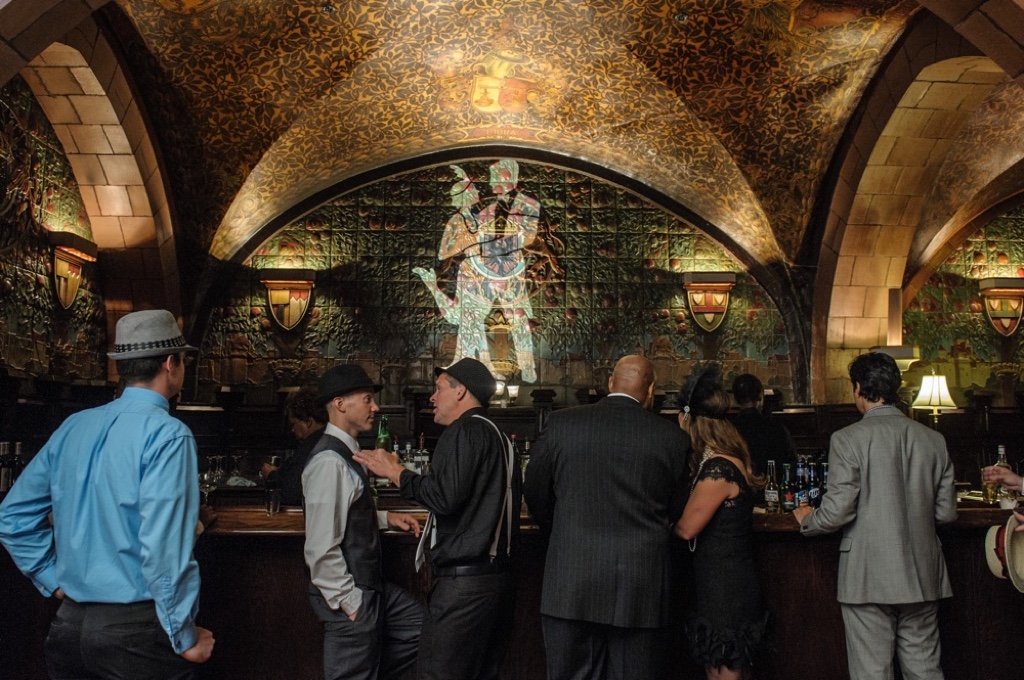Lasting Marks Of Prohibition In Louisville
Contributed by on Jan 17, 2017
Zero readers love this post.
DrinkWire is Liquor.com's showcase for the best articles, recipe and reviews from the web's top writers and bloggers. In this post, The Alcohol Professor takes us on a virtual tour of Louisville landmarks from the Prohibition era.
Prohibition agents emptying barrels of whiskey
Prohibition decimated the bourbon industry in Kentucky, and many distilling families just didn’t survive. In addition to the closure of distillation and maturation facilities, many hospitality-related businesses had to make adjustments to their way of doing business during this time. There are many famous and some not-so-famous stories about Prohibition life in Louisville. F. Scott Fitzgerald is said to have based his Jay Gatsby character on famous bootlegger George Remus, whom Fitzgerald met at the Old Seelbach Bar. Spirits still flowed there—covertly—during Prohibition, and a series of tunnels and hidden staircases kept those who chose to imbibe one step ahead of the law.
Today there are still echoes of Prohibition found all over Louisville. Not only are many of the tunnels still visible at The Seelbach, but also numerous distilleries have found a way to incorporate Prohibition lore into their visitor’s experiences.

bar in the Seelbach Hotel rathskeller, photo by Hilton
The Seelbach Hotel
Opened in 1905 by brothers Otto and Louis Seelbach, The Seelbach Hotel was on the cutting edge of style and luxury in the city. It was so popular they immediately began construction on an addition that would open two years later.
Many of the design features were revolutionary for the time. Though there was city water in Louisville already – the Louisville Water Company was founded in the 1860s and is one of the nation’s oldest – the brothers dug wells for backup. Sewer tunnels were also part of the original structure, though by the time of Prohibition they were no longer being used thanks to advances in sanitation, says Seelbach Historian Larry Johnson. Many of these tunnels would have led out to the street a few blocks away before other construction in the area closed them off for good.
Another system of tunnels was constructed when the Seelbach became the main provider of steam power for the area, selling steam to neighboring businesses via a network of underground pipes that ran through tunnels. Those tunnels ran beneath numerous businesses in the area until, again, construction closed them off.
Evan Williams Experience speakeasy entrance, photo by Maggie Kimberl
Both of these sub-basements are accessible from the Rathskeller’s service exit, so any patrons wishing to make a fast getaway would have easily been able to do so. In addition, there was a stairway out the main exit that went to every floor as well as directly into the poker room. Conceivably, someone from the poker room could have used this staircase to get to the Rathskeller, exit through the back service door, enter the sub-basement, and take one of the series of tunnels to freedom.
The Evan Williams Bourbon Experience
On the weekends local historian and author Rick Bell dresses up in Prohibition-era garb and offers a “Speakeasy Tour” to guests. The Evan Williams Experience went all out with this space, even incorporating a vault door with a sliding peephole that you need a password to get in. It’s a fun way to experience what Prohibition life might have been like, even if it's not an authentic space from the times.
Kentucky Peerless Distillery
Kentucky Peerless is one of the distilleries that was effectively put out of business by Prohibition, though they had already suspended production for the WWI war effort by 1919. Once the second largest distillery in Kentucky, when Prohibition was in full swing Henry Kraver* had no choice but to sell off his whiskey stocks to those who held medicinal licenses and get out of the business. His grandson, Corky Taylor, and great-grandson, Carson Taylor, decided to bring the family business back to life, reviving the old family name and distilled-spirits-producer number in the process. They were able to have the DSP-KY-50 designation re-activated and are operating under the same number as Henry Kraver did before Prohibition. They are also using a lower barrel entry proof than most major producers, another pre-Prohibition era throwback. Kentucky Peerless’ first rye whiskey will be available for sale in May 2017.
*Writer’s Note: Kentucky Peerless has reached out to Alcohol Professor to say, “We were actually one of the few distilleries to sell whiskey during Prohibition for medicinal purposes.” The six Kentucky distilleries that held medicinal licenses during Prohibition were: Brown-Forman, Glenmore, Frankfort Distilleries, Schenley, American Medicinal Spirits, and A. Ph. Stitzel (Cowdery). There were numerous whiskey brands available for sale during Prohibition, including H. Kraver Bourbon, though it was not being sold directly from Kentucky Peerless as they did not have a license to sell medicinal spirits. As there was no bourbon production during Prohibition save for a distiller’s holiday, those with medicinal licenses would purchase whiskey from those who had stock to sell, keeping the market open during this time period.
Peerless Distilling, photo by Maggie Kimberl
Why Mark The Start Of Prohibition?
Prohibition, a.k.a. the Volstead Act, took effect for the entire country on January 17, 1920 (after the enforcement of the 18th amendment) and lasted through December 5, 1933. Although many people still celebrate Repeal Day in Louisville — Bourbon Historian Michael Veach has advocated for making it a National Holiday — not many people mark its beginnings. It is important to recognize this day because, as Veach points out, Prohibition was the only Constitutional Amendment to take away a right instead of guaranteeing it.
For more on the aftermath of Prohibition in Kentucky, read an Alcohol Professor classic article here.



